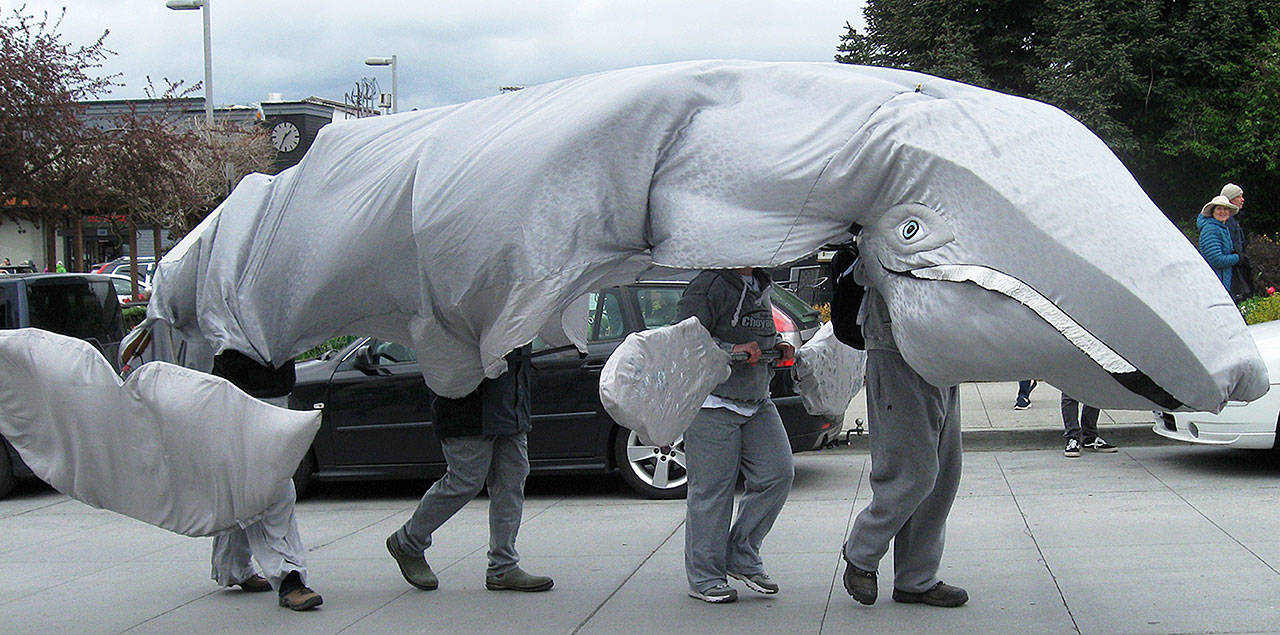The gray whales are back in waters around Whidbey Island, and Langley Mayor Tim Callison led a parade through town Saturday to welcome the giants of the deep. Judging from the festive atmosphere, the event offered the community another chance to come together and have fun.
Despite chilly wet weather, almost 200 residents and visitors, some in whale-related attire, sashayed up Second Street, down First, concluding with presentations at Whale Bell Park on the shore behind the old Dog House Building. This is the 18th year for the march formally known as the “Whale and Critter Parade.” Many marchers wore paper hats resembling a dorsal orca fin.
Earlier in the day, people gathered at Langley United Methodist Church to have conversations, make costumes and participate in a coloring contest.
At the park, 97-year-old Peter Lawlor read an original poem about whales, sang and played harmonica.
Dana Lyons played guitar and sang original songs about whales. She also spoke of the importance of setting up “quiet zones” in waterways such as Puget Sound so whales can seek refuge from the noise of boat engines.
Saturday evening, there were informational lectures and presentations back at the church fellowship hall.
In addition to the parade and other activities, Langley Whale Center Manager Wendy Sines said about 600 people visited the educational exhibit space on Anthes, between First and Second Streets, over the weekend. The weather apparently kept many people away, since visitation was about half of last year.
Courtney Cooke of the Whale Center said people are attracted to the ocean mammals because of their size, the mystery of their behavior and their almost-human socialization.
On Sunday, people again gathered at Whale Bell Park to pick up debris and clean the beach to protect the whale-feeding habitat. Sines noted the gray whales sometimes come close to the shore at high tide.
That morning, the Whale Center had a sunrise tour of 50 senior citizens from the Midwest and a Boy Scout troop from Oak Harbor.
“It was a fun weekend,” Sines said.
Sunday afternoon, ticketed passengers went on a gray whale cruise with Orca Network on board the Glacier Spirit, operated by Puget Sound Express. During gray whale season, the company operates tours from Langley every day except Tuesday and Wednesday, when the passenger minimum is reached. The Whidbey tours go on the Redhead, a 55-foot, 40-passenger boat.
Sines said about a dozen gray whales return in March to the waters around Whidbey. The whales stay and feed until early May before continuing a northward migration. One of the whales, know as Patch because of a prominent white forehead marking, has returned every year since 1991. Patch was represented by a costumed display in the parade.
“We have many visitors to the Langley Whale Center share their experiences and fascination with whales. They connect on an emotional level when they see whales in the wild, many report they are moved to tears and it changes their life,” Sines said
“Even those who haven’t seen the whales feel a kinship, especially to orca, when they learn about the close family bond the animals share.”
The parade featured several displays, including one which Whidbey artists Molly Brown and Melissa Koch called “artful activism.” They crafted two five-foot-long salmon sculptures from reed, gauze and hemp twine. The sculptures were carried with a banner promoting restoration of salmon to provide necessary food supplies for orca.
Even though the orca have no predators, their survival is perilous because of the dramatic decline of chinook salmon, a primary food source. The population of resident orca in Washington and British Columbia has declined to only about 75 in recent years, and there have been few births.
The Whidbey stopover is part of a 10,000-mile journey the gray whales make every year as they travel from Mexico’s Baja Peninsula to the Aleutian Islands of Alaska and back. It is one of the longest migratory paths of any mammal.
The Langley Whale Center is a project of the nonprofit Orca Network, aimed at “connecting whales and people in the Pacific Northwest.” The center is open Thursday through Monday, from 11 a.m. to 5 p.m.



